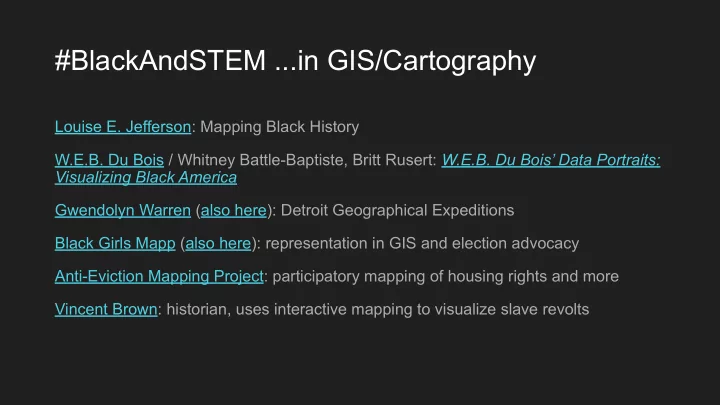

#BlackAndSTEM ...in GIS/Cartography Louise E. Jefferson: Mapping Black History W.E.B. Du Bois / Whitney Battle-Baptiste, Britt Rusert: W.E.B. Du Bois’ Data Portraits: Visualizing Black America Gwendolyn Warren (also here): Detroit Geographical Expeditions Black Girls Mapp (also here): representation in GIS and election advocacy Anti-Eviction Mapping Project: participatory mapping of housing rights and more Vincent Brown: historian, uses interactive mapping to visualize slave revolts
Projections, why they matter, and districting
1. Introduction to projections 2. Why projections matter 3. Considerations for districting 4. Setting projections in QGIS
“Visually depicting space and power --- cartography --- is a political act in every sense. Maps represent things not as they are, but as we need or want them to be for particular purposes. -- Jessica A. Krug, Fugitive Modernities
https://www.atlasob scura.com/articles/ mercator-peters-bo ston-map
From the Earth to a sphere to a map …
Earth to Sphere: Geographic Coordinate System (GCS) (sometimes aka datum)
Geographic coordinates: Latitude and Longitude (parallels and meridians)
Examples of lat/long... Boston: 42.4° N, 71.1° W Oahu, Hawai’i: 21.4° N, 158.0° W Montgomery, Alabama: 32.4° N, 86.3° W ⅓ and ⅔ cuts of New York State: 42° N, 44° N Tufts University: 42.40° N, 71.12° W MGGG’s Redistricting Lab at Tufts University: 42.4079° N, 71.1209° W
Thanks, XKCD
Sphere to (flat) map: Projected Coordinate Systems (PCS) aka projections Note: projections include a GCS
Projected Coordinate Systems (PCS) aka projections Start with a developable surface ● Cylinder ● Cone ● Plane ● (mathematical)
All projections distort https://www.leventhalmap.org/digital-exhibitions/ bending-lines/interactives/projection-face/
Projections also can preserve certain properties: ● Conformal: preserves angles (~shapes) ● Equivalent (equal area): preserves areas ● Equidistant: preserves distance to anywhere on the map ○ …from either one point (planar) ○ …or two points (cylindrical and conic) ● Azimuthal: preserves direction from a single point (all are planar) ● Compromise: balances shape, area, direction, and distance https://www.leventhalmap.org/digital-exhibitions/bending-li nes/interactives/tissots-indicatrix/
Compromise Projections Winkel Tripel Robinson
Case: intersection with reference globe Tangent: rests on top of the reference globe Secant: slices through reference globe Properties preserved at standard lines(s) In QGIS: Lat_1 and Lat_2
Aspect: orientation of developable surface to ref. globe Normal: developable surface oriented parallel to Earth’s axis of rotation Transverse: developable surface oriented 90° from Earth’s axis of rotation Oblique: developable surface is neither normal nor transverse
Review Pay attention to: Geographic Coordinate System (GCS) ● Projected Coordinate System (PCS, or “projection”) ● ○ Includes GCS ○ Centering ■ Standard lines: often lat_1 and lat_2 ■ Longitudinal center for normal case: lon_0
Why do projections matter?
Why do projections matter? In general... Getting your message across: ● ○ What does the world look like? Mercator versus Peters ○ Should North be up? ○ Meeting the purpose of your map: ● ○ Navigation ○ Representing another variable in specific areas (e.g., race using color or dots) ○ Showing how places relate to one another ○ Doing spatial analysis ● ○ Area of specific polygons? ○ Distance between places or from a point? ○ Equal-area maps: more socially just? ● ...or maybe they don’t? “[W]e don’t need a new map; we need a new view of the world.” - Peters
Why do projections matter? In Districting/MGGG work... Districtr Mapmaking Dot maps ● Choropleths ● Compactness Precinct work: locally appropriate and consistent
Projections in QGIS Coordinate Reference System (CRS): ● Geographic Coordinate System (GCS) ● Projected Coordinate Systems (PCS, includes GCS)
Projections in QGIS Based on libraries used in open-source mapping ● ○ European Petroleum Search Group (EPSG) ○ Institut Geographic National de France (IGNF) ○ (Environmental Systems Research Institute: ESRI) EPSG numbers used as shorthand for projections ● ○ Can remember name or EPSG number ○ e.g., 3310: Albers Equal Area, Centered on California, using GCS NAD83
Some common Geographic Coordinate Systems Most common: ○ WGS84 (World Geodetic System 1984): EPSG 4326 ○ NAD83 (North American Datum 1983): EPSG 4269
Some Common Projections (Projected Coordinate Systems) ● Albers Equal Area (conic) Lambert Conformal Conic (conic) ● ● Mercator (cylindrical) ○ UTM: Universal Transverse Mercator ○ Web Mercator ● State Plane: locally parameterized for each state (two per state) ○ Lambert conformal conic ○ Transverse mercator ● Plate Carree (Cylindrical): “unprojected”
A note... If a PCS is not set, QGIS has to guess or set one ○ Default: Plate Carree
Projections in QGIS
Identifying and Setting a layer’s projection ● Temporary: Layer Properties → Geometry and CRS ● Permanent: Export → Save features as → CRS Note: If you attempt to bring in a layer with a different GCS, QGIS will ask to do a datum transformation to align the layers.
Setting a project’s projection ● Automatically set from first layer added ● To change: ○ Layer: Set Project CRS from layer ○ Project → Properties → CRS
Guidelines Choose what kind of distortion to minimize: Angles/shape ● Area ● Distance ● Direction ● More than one ● Choose a projection that is EITHER: Locally parameterized, OR ● Generally appropriate and set local (custom) parameters (rare for ● QGIS)
Clues your projection is “off” ● Known boundaries are at strange angles ○ Your projection isn’t centered on the area of your layer (e.g., a North America projection for Maine) ● When you zoom to a layer, you can’t see the others ○ Could also be an issue of generalization (level of detail)
Recommend
More recommend